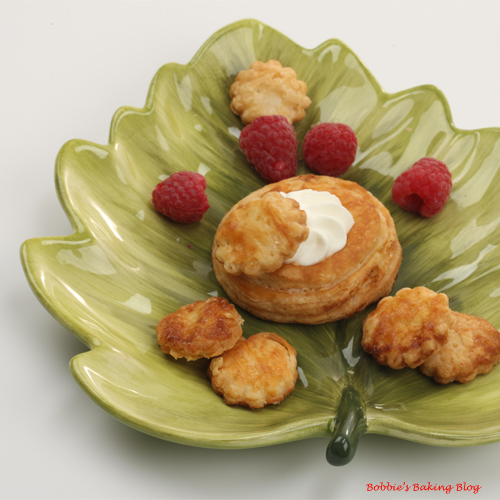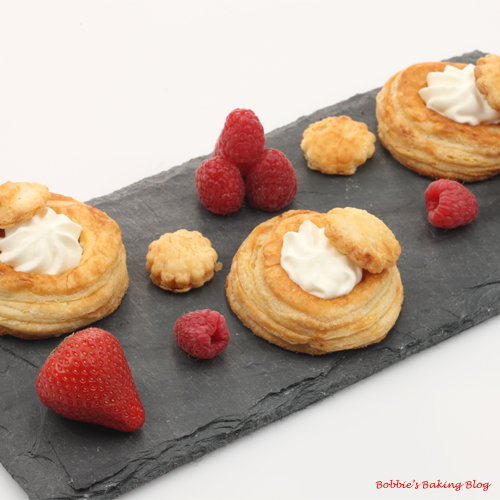Puff pastry can be the base for many treats including this Pâte d’Amande Gâteau Mousse Blanc (see below for recipe).
When I teach pastry classes, so many students become petrified at the thought of fresh pâte feuilletée (puff pastry). I know it sounds daunting and, with the ready-made puff pastry in the freezer aisle, unnecessary. I can honestly say your palate will know the difference; once you’ve had handmade pâte feuilletée you will skip buying the store-bought puff pastry.
I remember in a three-day class on “The Versatility of Pâte Feuilletée” there happened to be a young woman who turned three shades of green upon hearing we would be making handmade puff pastry. This woman insisted success would elude her; in fact she wanted to be an observer instead of a participant. On the last day of class this woman had a pâton of puff pastry dough, and has continued to hand-prepare puff pastry at home.
Once you have mastered your own puff pasty dough there is a plethora of treats the dough can be the base for. Here are just a few: Napoleons, Palmiers, Tart Tatins, Vol-au-Vent.
Sydney’s Pâte d’Amande Gâteau Mousse Blanc
Vol-au-Vent Bowls (Puff Pastry Bowls) and Chapeaux Petite:
Puff pastry has to be one of the most versatile doughs; it rises, but does not have yeast. True pâte feuilletée (puff pastry) is distinctive; once you have had a handmade pâte feuilletée there is no going back to the box.
Pâte Feuilletée:
Passover and gluten free version
261 grams /1 2/3-cup, plus 1-tablespoon rice flour
192 grams/ 1/2 rice starch
1 -tablespoon xanthan gum
2- teaspoons agar powder
296 grams/10 ounce water
Beurrage
454 grams/ 16 ounces cold unsalted butter:
4 grams/2-teaspoons rice starch (extra needed to add moisture)**
Prepare your mise en place: a damp cool towel, and all-purpose flour for dusting the work surface.
The Détrempe:
1. In a food processor fitted with the metal blade pulse the rice flour, 192 grams rice starch, xanthan gum, agar gum, and salt a couple of times just to mix. Add the water all at once; pulse until the dough forms a ball on the blade. The dough should be pliable, moist and sticky.
2. Remove the dough from machine, form a ball (your ball will be sticky) and with a very sharp knife slice diagonally . Wrap the dough in a moisten damp towel and refrigerate for about 25 minutes.
The Beurrage:
1. Meanwhile place the butter between some plastic wrap, beat butter and 4 grams rice starch with a rolling pin (this is an awesome way to let off some aggression) or a metal scraper until if flattens and is pliable and still cool, form the butter into a little ½ -1-inch square. Make sure the butter remains cool. If the butter seems to be warming up or feeling “greasy” place it back into either the refrigerator or freezer until it is cool once again.
2. Grab the dough from the chilly refrigerator, unwrap, and check that the détrempe and the beurrrage are the same consistency and place on a very cold lightly floured surface.
3. Keep rolling the dough on a cold surface and flour the surface enough to prevent the pastry dough from sticking. Most importantly the détrempe and the beurrage need to the same cool temperature.
4. With a good heavy rolling pin gently roll the chilled rested détrempe to create a thicker center square with ears on each corner, just large enough to wrap/enclose the barrage. (like and envelope)
5. Place the chilled beurrage in the middle of détrempe (the beurrage should be angled like a diamond). First fold one set of opposite flaps over the butter and than the remaining two ears completely enclose the beurrage. Pinch the dough together to lightly seal, creating a piton.
**To make a great puff pastry, it is important to keep the dough cold at all times.
6. Using the rolling pin press lightly the pâton about four to five times lengthwise or until it 23cm/9-inches long and 9mm/3/8-inch thick. Brush off the excess flour, fold the dough in thirds like a business letter being sure to fold the top side first and bottom side up, first turn is complete, rotate the dough so the fold edge/spine is facing to the left. Using the length of rolling pin works well.
7. Making the turns, gently but with a firm hand press the rolling pin against the top and bottom of the square (this will keep it a square shape). Then, keeping the work surface and the top of the dough well floured roll the dough into a rectangle that’s is 3 times longer than the original square, about 24-inches long. With the first roll it is very important that the incased butter be rolled evenly along the length and width of the rectangle; check when you begin rolling that the butter is moving along well, and roll a bit harder or more evenly if necessary, to obtain a smooth, even dough-butter sandwich. With a pastry brush, brush off the excess flour from the top of the dough and fold the rectangle up from the bottom and down from the top in thirds, like a letter, brush off the excess flour. You have completed one turn, this called the tourage.
8. Rotate the dough so that the closed fold is to your left, like the spine of a book. Repeat the rolling and folding process, rolling the dough again 24-inches in length and folding into thirds. This is the second turn. Place two finger print dots to keep track of the turns.Wrap the piton in plastic wrap and place in the refrigerator.
9. Chill the dough for 60 minutes wrapped in plastic wrap. This processes needs to be repeated six turns or 3 times marking by indenting your fingerer two times for each two turns.
10. After the six turns the pâte feuilletée is ready for use, or if not using within 24 to 48 hours wrap in freezer paper, plastic wrap, and place in the freezer ( the pâte feuilletée will last up to one month).
11. Prior to using from the freezer place in refrigerator to defrost.
Vols-au-Vents:
1/3 recipe puff pastry,defrosted in the refrigerator
egg wash
50 grams/ 1/4-cups sugar
flour for dusting
1. Prepare your mise en place. Preheat oven to 180 degreesC/350degreesF.
2. Line a baking sheet will a silpat or parchment paper and set aside.
3. Lightly flour your working surface and turn dough as you roll out the dough, DO NOT ALLOW THE DOUGH TO STICK. Roll the dough to 3-6 mm/ 1/8-1/4 inch thicknesses.
4. Using a round 4cm/1-inch cutter cut out circles, us a smaller cutter inside the circles for the 12 rings with a 6mm/ 1/4-inc boarder. For larger sized vols-au-vent, fit for a main course or dessert, use a 10cm/ 4-inch cutter to cut out about 4 circles, again use a smaller circle cutter for the rings. You can use a metal ring or cookie cutter cut 16 to 20 disks.cut . Brush the top rings lightly with egg wash, trying not to drip any down the sides (which may inhibit rise). If you are using the little “caps,” dock and egg wash them as well.
5. Using a smaller round cutter cut ½ of disks centers out, and save.
6. Create an egg wash and set aside.
7. Dock the disks; with a pastry brush lightly coat each disk with the egg wash. Place disk on prepared baking sheet and layer pastry rings on top of each disk. Using a pastry brush lightly and gently coat with egg wash. Add just enough egg wash to slightly wet the surface without dripping down the sides.
8. Use the small disk for the top: Chapeaux Petite brush with egg wash, add to the oven about 10 minutes after you added the Vols-au-Vent. Keep disk centers in the refrigerator.
9. Place completed Vols-au-Vant (and the smaller disks, if using) on the prepared baking sheet; place a piece of parchment paper over the top of the Vols-au-Vant. This should ensure even rising, and to also prevent the pastry ring from distorting or tumbled during baking. Place the baking sheet with the Vols-au-Vent in the refrigerator while the oven heats to temperature.
10. Bake until golden brown and inside is completely cooked.
11. Remove from the oven and place on cooling rack till cooked. The Vols-au-Vent can be used for sweet or savory dishes.
Crème Whipped Topping:
165 grams Crème Frâiche
29 grams/ 1/8-cup mascarpone cheese
145 grams/ 2/3-cup cream
15 grams / 2-Tablespoons icing or confectioner’s sugar
1. Using a cold bowl from your standing mixer with whisk attachment add the crème frâiche, mascarpone, cream and whisk till a line begins to show in the crème, slowly add icing sugar and whisk on medium speed till soft light peaks form.
2. Place the whipped crème in a pastry bag with a a large star piping tip and pipe into Vols-au-Vent. Use the Chapeaux Petite (small caps) to lay on the top side.
A Savory Dish: Smoked Salmon Mousse
300 grams/ 12 ounces smoked salmon
170/ 3/4-cup mascarpone cheese
9 grams/ 2 teaspoons double or heavy cream
1 shallot, minced and sautéed
44 grams/-1/4 cup white wine
Whole white peppercorns, cracked to taste
1. Place the smoked salmon, mascarpone cheese, double cream, sautéed shallots in a food processor fitted with the metal blade and processes till smooth and has a satin sheen. Scrape down the sides of processor bowl as needed. Add the white wine, white pepper and pulse to combine to blend.
2. Place Salmon Mousse on a piping bag fitted with a large open tip or star tip and pipe into Vols-au-Vent.
3. Garnish with a few dill sprigs and the Chapeaux Petite.
**Although they are at their best filled and eaten after baking, baked vols-au-vent shells can be stored in an airtight container for a few days.
*Shaped, unbaked vols-au-vent can be wrapped and frozen for up to a month 
Happy Passover
Sydney’s Pâte d’Amande Gâteau Mousse Blanc









Is the gluten free version harder than normal pate feulletée? Great idea, here’s hoping I can duplicate the recipe.
Yum these look delicious! I have never heard of a gluten free puff pastry, I think you are on to something great! Keep it up!
I love almond so I will especially like this! Where did you get the idea for this recipe? Its defiantly a must have!! And your pictures look something out of a magazine!
Idea was my daughters, she love almond paste.
I’ve been trying to make puff pastry for almost a month now, for some reason I am not getting the layers. I am not quite sure why, is there any pointers you can give me? Thank you.
The beurrage and dètrempe must be the same consistency and temperature. just try to be patient, you will achieve your layers
Great recipe.
In your recipe, you write agar gum and agar powder. It’s the same ingredient?
Laurent, Having trouble seeing where agar gum is written, can you point in the direction where you saw it?